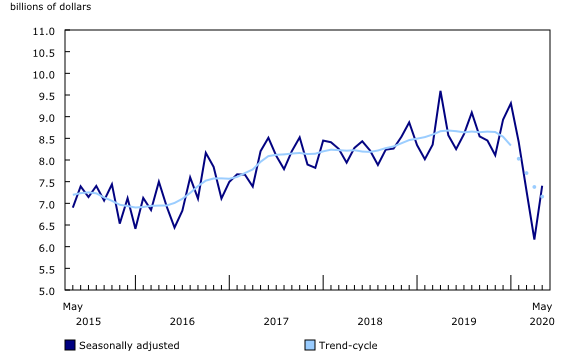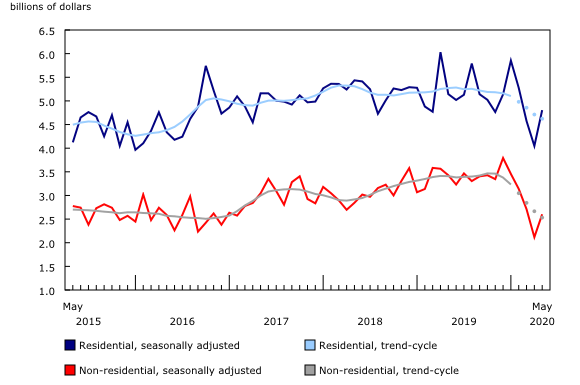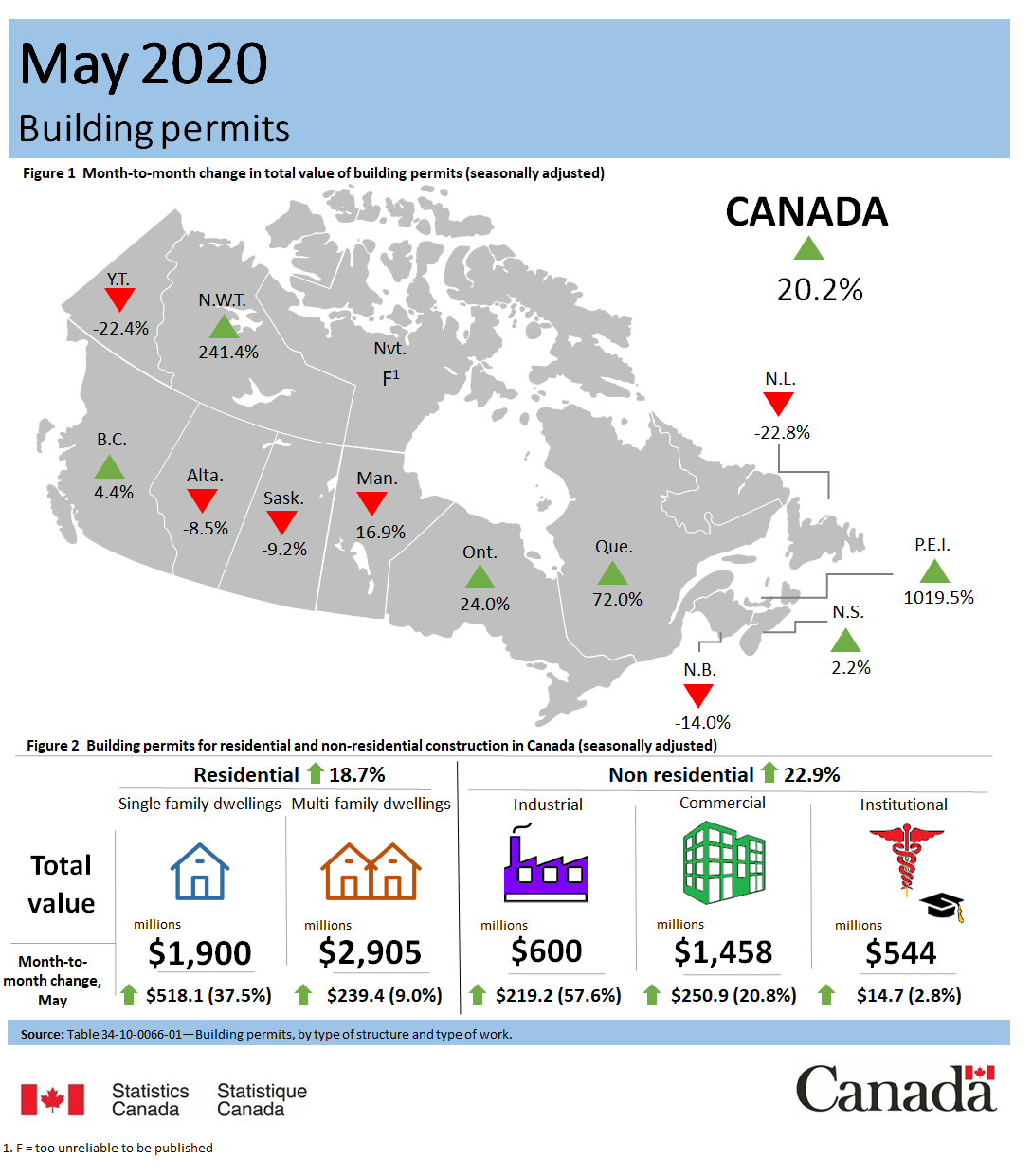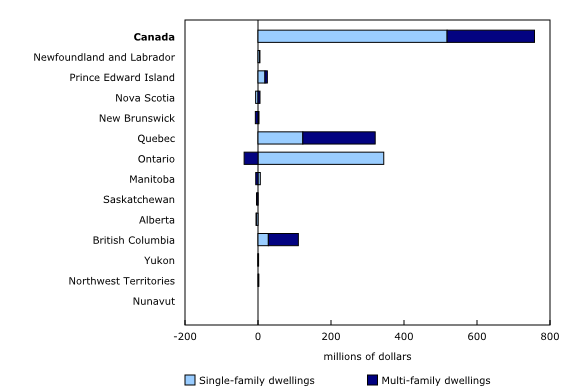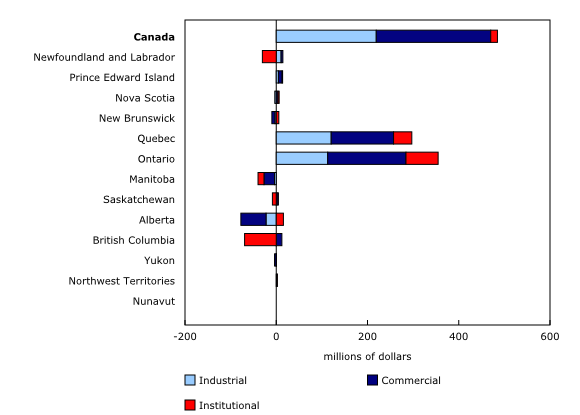Building permits, May 2020
Archived Content
Information identified as archived is provided for reference, research or recordkeeping purposes. It is not subject to the Government of Canada Web Standards and has not been altered or updated since it was archived. Please "contact us" to request a format other than those available.
Released: 2020-06-29
$7.4 billion
May 2020
20.2% 
(monthly change)
$37.0 million
May 2020
-22.8% 
(monthly change)
$43.5 million
May 2020
...%
(monthly change)
$105.7 million
May 2020
2.2% 
(monthly change)
$53.1 million
May 2020
-14.0% 
(monthly change)
$1,476.5 million
May 2020
72.0% 
(monthly change)
$3,417.9 million
May 2020
24.0% 
(monthly change)
$195.4 million
May 2020
-16.9% 
(monthly change)
$77.2 million
May 2020
-9.2% 
(monthly change)
$718.7 million
May 2020
-8.5% 
(monthly change)
$1,267.6 million
May 2020
4.4% 
(monthly change)
$7.9 million
May 2020
-22.4% 
(monthly change)
$5.5 million
May 2020
241.4% 
(monthly change)
F
May 2020
F
(monthly change)
The total value of building permits issued by Canadian municipalities in May bounced back 20.2% to $7.4 billion, following declines of 13.4% in March and 15.4% in April. This was the largest percentage increase since March 2009, and it coincided with the relaxing of COVID-19 construction restrictions in Ontario, Quebec and Prince Edward Island. The May level is still 20.4% below the last peak observed in January 2020.
Although all provinces still had public health guidelines in place in May, Ontario, Quebec and Prince Edward Island had the most impactful policy changes during the month. In Ontario, some non-residential construction projects were reopened starting May 4. Additionally, the province moved into Stage 1 of reopening on May 19, which included a full resumption of all construction projects.
In Quebec, all sectors of the construction industry in all regions were authorized to resume activity on May 11 under strict guidelines of the Commission des normes, de l'équité, de la santé et de la sécurité du travail. Lastly, in Prince Edward Island, new construction projects were permitted to start on May 1, following a five-week work stoppage.
Reflecting these policy changes, the largest increases in the value of permits were in Quebec (+72.0%) and Ontario (+24.0%). Prince Edward Island posted the largest gain in the value of permits among the Atlantic provinces and the largest percentage increase across the country (+1,019.5%), following a drastic 87.6% drop in April.
Single-family permits post record gain
The total value of residential permits was up in six provinces in May, increasing 18.7% to $4.8 billion nationally. The largest increase was in Quebec, up 53.4% for the month. On April 20, Quebec reopened residential construction to be delivered by July 31; the remainder of the construction sector was reopened on May 11.
The vast majority of residential gains were attributable to increases in the value of permits for single-family homes, which rose by a record $518 million (+37.5%), following a drop of 34.6% in April. Seven provinces reported gains, led by Ontario and Quebec.
The value of permits for multi-family dwellings increased 9.0% to $2.9 billion, driven by projects in the Montréal and Vancouver census metropolitan areas (CMAs).
Non-residential permits increase
The value of commercial permits was up 20.8% to $1.5 billion in May, with the largest increases reported in Ontario (+26.3%) and Quebec (+147.8%).
Industrial permits jumped 57.6% to $600 million, following a substantial decrease in April. This increase was largely driven by a permit for a Molson brewery in the CMA of Montréal.
Institutional permits posted their first gain for 2020, increasing 2.8% to $544 million. Permits for postsecondary institutions led the increase.
For more information on housing, please visit the Housing Statistics Portal.
To explore the impact of COVID-19 on the socioeconomic landscape, please visit the COVID-19 dashboard.
Note to readers
Unless otherwise stated, this release presents seasonally adjusted data, which facilitate month-to-month comparisons by removing the effects of seasonal variations. For information on seasonal adjustment, see Seasonally adjusted data – Frequently asked questions.
The Building Permits Survey covers over 2,400 municipalities, representing 95% of the Canadian population. The communities representing the other 5% of the population are very small, and their levels of building activity have little impact on the total for the entire population.
Building permit data are used as a leading indicator of activity in the construction industry.
The value of planned construction activities presented in this release excludes engineering projects (such as waterworks, sewers or culverts) and land.
For the purposes of this release, the census metropolitan area of Ottawa–Gatineau (Ontario and Quebec) is divided into two areas: the Ottawa part and the Gatineau part.
Unless otherwise specified, the highlights refer to seasonally adjusted current dollars and are ranked in terms of dollar change rather than percentage change.
Building components
Single-family dwellings: Residential buildings containing only one dwelling unit (for example, single-detached house, bungalow, linked home [linked at the foundation]).
Multi-family dwellings: Residential buildings containing multiple dwelling units (for example, apartment, apartment condominium, row house, semi-detached house).
Industrial buildings: Buildings used in the processing or production of goods, or related to transportation and communication.
Commercial buildings: Buildings used in the trade or distribution of goods and services.
Institutional and government buildings: Buildings used to house public and semi-public services, such as those related to health and welfare, education, or public administration, as well as buildings used for religious services.
Revision
Unadjusted data for the current reference month are subject to revision based on late responses. Data for the previous two months have been revised. Seasonally adjusted data for the previous three months have also been revised.
Trend-cycle estimates have been added to the charts as a complement to the seasonally adjusted series. Both seasonally adjusted data and trend-cycle estimates are subject to revision as additional observations become available. These revisions could be large and could even lead to a reversal of movement, especially at the end of the series. The higher variability associated with trend-cycle estimates is indicated with a dotted line on the chart.
For information on trend-cycle data, see the StatCan Blog and Trend-cycle estimates – Frequently asked questions.
Contact information
For more information, or to enquire about the concepts, methods or data quality of this release, contact us (toll-free 1-800-263-1136; 514-283-8300; STATCAN.infostats-infostats.STATCAN@canada.ca) or Media Relations (613-951-4636; STATCAN.mediahotline-ligneinfomedias.STATCAN@canada.ca).
- Date modified:


